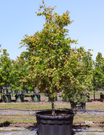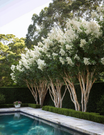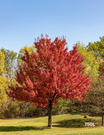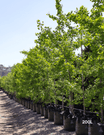In today’s fast-paced urban environments, the presence of trees plays a crucial role in fostering sustainability and enhancing our quality of life. Trees like Gleditsia triacanthos 'Shademaster', Fraxinus pennsylvanica 'Urbanite' (Green Ash), and Quercus rubra (Northern Red Oak) are not just aesthetic additions to our gardens; they are vital contributors to environmental health. This blog post delves into how these remarkable trees improve local air quality, their unique features, and tips for selecting and planting them effectively.
Why Trees Matter for Urban Sustainability
Pollution, heat islands, and limited green spaces often burden urban areas. Trees offer a natural solution to these challenges by filtering air pollutants, reducing energy costs, and promoting biodiversity. They absorb carbon dioxide and release oxygen, creating a healthier environment. By strategically selecting and planting trees, we can enhance our urban landscapes' sustainability.
The Economic Benefits of Trees in Urban Areas
In addition to their environmental advantages, trees provide significant economic benefits to urban areas. Studies have shown that properties with well-maintained trees can increase property value, making them a wise investment for homeowners. Here’s how:
- Increased Property Value: Homes with mature trees can sell for 10-15% more than similar homes without trees, appealing to buyers seeking aesthetic and environmental benefits.
- Reduced Energy Costs: Trees can lower energy bills by providing shade in the summer and windbreaks in the winter, reducing the need for air conditioning and heating.
Gleditsia triacanthos 'Shademaster'
The Gleditsia triacanthos 'Shademaster', commonly known as the Shademaster Honeylocust, stands out for its dense, lush foliage that provides ample shade. This tree is ideal for creating inviting outdoor spaces and reducing energy consumption through natural cooling.
Key Facts
- Mature Height: 12-15 meters
- Mature Width: 10-12 meters
- Best Uses: Feature tree, shade tree
- Leaf Appearance: Fern-like leaves that turn a vibrant yellow in autumn
- Rate of Growth: Moderate to fast
- Tolerates: Drought, urban pollution, compacted soils

Why It's Perfect to Add to Your Garden
Incorporating Gleditsia triacanthos 'Shademaster' into your garden enhances its aesthetic appeal and offers practical benefits. This tree’s high tolerance to urban conditions makes it an excellent choice for city gardens, where space and environmental stresses are concerns. Its ability to filter airborne pollutants means cleaner air for you and your family, making it a smart addition to any high-end landscape.
Fraxinus pennsylvanica 'Urbanite'
The Fraxinus pennsylvanica 'Urbanite', or Green Ash, is a robust tree known for its resilience in urban settings. Its sturdy structure and lush foliage make it a valuable asset for those seeking to enhance their outdoor spaces with low-maintenance greenery.
Key Facts
- Mature Height: 10-15 meters
- Mature Width: 8-12 meters
- Best Uses: Shade tree, street tree
- Leaf Appearance: Dark green, glossy leaves that provide dense shade
- Rate of Growth: Fast
- Tolerates: Air pollution, drought, wet soils

Why It's Perfect to Add to Your Garden
Adding Fraxinus pennsylvanica 'Urbanite' to your property creates a cooling effect during the hotter months and contributes significantly to improving air quality. This tree thrives in urban environments, showcasing its adaptability while requiring minimal maintenance. Its ability to withstand pollutants ensures that it remains a vibrant feature in your garden for years.
Quercus rubra (Northern Red Oak)
The Quercus rubra, or Northern Red Oak, is celebrated for its stunning fall color and robust structure. This tree is a magnificent focal point in any garden, combining beauty and functionality.
Key Facts
- Mature Height: 15-20 meters
- Mature Width: 12-15 meters
- Best Uses: Feature tree, park tree, wildlife habitat
- Leaf Appearance: Lobed leaves that turn a brilliant red and orange in fall
- Rate of Growth: Moderate to fast
- Tolerates: Varied soil types, moderate drought, urban conditions

Why It's Perfect to Add to Your Garden
The Quercus rubra not only enhances your landscape with its striking seasonal changes but also plays a vital role in carbon sequestration. By planting this majestic tree, you contribute to a healthier urban ecosystem, supporting local wildlife and enhancing biodiversity. Its impressive stature and environmental benefits make it an ideal choice for discerning clients looking to invest in sustainable landscaping.
Creating a Diverse Urban Canopy
A diverse tree canopy is essential for a resilient urban environment. Planting a variety of species like Gleditsia triacanthos 'Shademaster', Fraxinus pennsylvanica 'Urbanite', and Quercus rubra contributes to the overall health of the ecosystem:
- Biodiversity: A mix of species supports a wider range of wildlife, creating habitats for birds, insects, and other organisms that contribute to a balanced ecosystem.
- Disease Resistance: Planting diverse species reduces the risk of disease and pest outbreaks that can devastate monoculture plantings, ensuring a robust urban forest for generations to come.
Conclusion
Incorporating trees like Gleditsia triacanthos 'Shademaster', Fraxinus pennsylvanica 'Urbanite', and Quercus rubra into urban landscapes offers numerous environmental benefits, from improving air quality to promoting biodiversity. Selecting the right trees not only enhances the beauty of your garden but also contributes to a more sustainable future. By understanding their unique qualities and requirements, you can make informed decisions that align with your values of efficiency, quality, and subtle luxury.
FAQs
1. How do trees filter air pollutants?
Trees absorb carbon dioxide and pollutants like sulfur dioxide and nitrogen oxides through their leaves and bark. They also trap particulate matter on their surfaces, improving overall air quality.
2. What is the best time to plant trees?
The ideal time for planting trees is early spring or autumn, when temperatures are mild and moisture is more abundant, allowing for better root establishment.
3. How can I maintain these trees in an urban environment?
Regular watering during dry spells, mulching to retain soil moisture, and pruning to remove dead branches are essential for maintaining the health of urban trees.
4. What are the benefits of planting trees in urban areas?
Planting trees in urban areas helps reduce heat, improves air quality, provides habitat for wildlife, and enhances the aesthetic appeal of the environment.









































Leave a comment
This site is protected by hCaptcha and the hCaptcha Privacy Policy and Terms of Service apply.